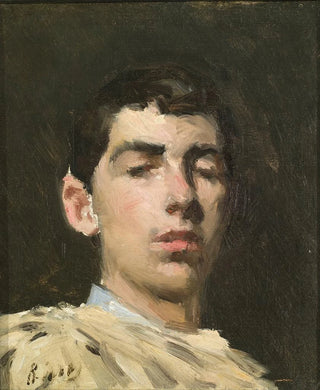Art print | Self-portrait - Ramon Casas


View from behind

Frame (optional)
Ramon Casas Self-Portrait Art print – Captivating Introduction
The Ramon Casas Self-Portrait art print is a work that transcends the simple act of self-representation. As an emblematic artist of Catalan modernism, Casas succeeds in capturing not only his image but also the essence of a rapidly changing era. This piece, both intimate and universal, invites the viewer to delve into the artist's inner world while offering a fascinating glimpse into the artistic trends of the late 19th century. Contemplating this work, one feels a deep connection with the artist, as if each brushstroke tells a personal and collective story.
Style and uniqueness of the work
The Self-Portrait art print stands out for its bold style and innovative use of color and light. Ramon Casas, master of portraiture, plays with shadows and reflections to bring his image to life. The artist's frank and penetrating gaze seems to challenge the viewer, while offering a moment of reflection on the nature of identity. The color palette, both rich and nuanced, evokes an atmosphere of melancholy and introspection. Every detail, from the choice of clothing to the expression on the face, contributes to creating a piece that is both a mirror and a window into the soul of its creator. This blend of realism and symbolic elements allows the Self-Portrait art print to resonate with striking modernity, echoing contemporary concerns about identity and self-perception.
The artist and his influence
Ramon Casas is a central figure of the Spanish modernist movement, and his work has had a significant impact on art in Catalonia and beyond. Trained in Paris, he was influenced by the artistic currents of his time, notably Impressionism and Symbolism. Casas managed to incorporate these influences while developing a style that is uniquely his own, characterized by a particular attention to light and color. His work goes beyond simple portraiture to explore universal themes such as solitude, introspection, and existential anxiety. As an active member of his artistic scene, he also played a key role in promoting Catalan art, contributing to the emergence of a strong regional artistic identity.

Matte finish

View from behind

Frame (optional)
Ramon Casas Self-Portrait Art print – Captivating Introduction
The Ramon Casas Self-Portrait art print is a work that transcends the simple act of self-representation. As an emblematic artist of Catalan modernism, Casas succeeds in capturing not only his image but also the essence of a rapidly changing era. This piece, both intimate and universal, invites the viewer to delve into the artist's inner world while offering a fascinating glimpse into the artistic trends of the late 19th century. Contemplating this work, one feels a deep connection with the artist, as if each brushstroke tells a personal and collective story.
Style and uniqueness of the work
The Self-Portrait art print stands out for its bold style and innovative use of color and light. Ramon Casas, master of portraiture, plays with shadows and reflections to bring his image to life. The artist's frank and penetrating gaze seems to challenge the viewer, while offering a moment of reflection on the nature of identity. The color palette, both rich and nuanced, evokes an atmosphere of melancholy and introspection. Every detail, from the choice of clothing to the expression on the face, contributes to creating a piece that is both a mirror and a window into the soul of its creator. This blend of realism and symbolic elements allows the Self-Portrait art print to resonate with striking modernity, echoing contemporary concerns about identity and self-perception.
The artist and his influence
Ramon Casas is a central figure of the Spanish modernist movement, and his work has had a significant impact on art in Catalonia and beyond. Trained in Paris, he was influenced by the artistic currents of his time, notably Impressionism and Symbolism. Casas managed to incorporate these influences while developing a style that is uniquely his own, characterized by a particular attention to light and color. His work goes beyond simple portraiture to explore universal themes such as solitude, introspection, and existential anxiety. As an active member of his artistic scene, he also played a key role in promoting Catalan art, contributing to the emergence of a strong regional artistic identity.






